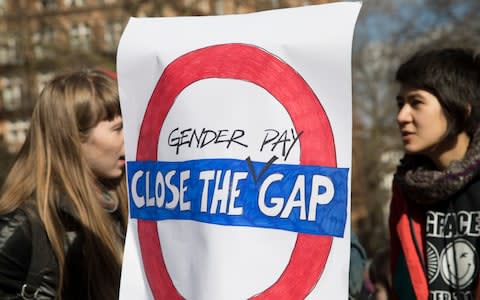The British companies with no gender pay gap - and how they did it

Women Mean Business banner
By Wednesday this week, all UK companies employing 250 people or more will have had to publish statistics revealing their gender pay gap. Many have already done so, and thus far it has made for troubling headlines.
“Women are short-changed in the UK,” declared one article last week. Why? Because, of the organisations that had reported their figures by that point, more than three-quarters were found to be paying their male staff more. Among the worst offenders, the gender pay gap stood at more than 80 per cent. And some of Britain’s most high profile companies have reported gaps three times higher than the national average - 18.4 per cent for full-time and part-time workers combined, and 9.1 per cent for full-time workers only - with Easyjet paying women 51.7 per cent less, on average, and HSBC declaring a gap of 59 per cent.
At the weekend, with just days to go until the deadline, around a quarter of eligible British companies still hadn’t reported at all. None of which makes for cheerful tidings in a country that likes to regard itself as a bastion of progress and equality.
Yet, it’s not all bad news. In a minority of cases, the gap between male and female earnings was either very small or non-existent. In some workplaces, women were even paid more than men.
At Unilever UK, for instance, women earn around 9 per cent more than men, reflective of the fact that 70 per cent of those working in manufacturing roles are male, while more than half (50.7 per cent) of all management positions at the consumer goods giant are occupied by women. At the online supermarket Ocado, women are paid 1.4 per cent more than men per hour. At the British Museum, male and female staff are paid exactly the same.

At Channel 5, the gender pay gap is 2.85% per cent in favour of female employees - a stark contrast with the other UK broadcasters. By comparison, Channel 4 has a mean gender pay gap of 28.6 per cent, ITN's is 19.6 per cent, Sky revealed an average of 17.5 per cent, and the BBC’s highly publicised pay gap comes in at 9.3 per cent.
Thanks in large part to the row at the BBC, pay in this industry has been much in the spotlight of late. So how, we might ask, has Channel 5 come so much closer to achieving pay parity than any of its rival broadcasters?
A closer look at the organisation reveals the steps it has been taking to tackle the historic discrepancy between the earnings of male and female staff. The gender pay gap, as defined by the Equality and Human Rights Commission (EHRC), is a measure of the difference between men’s and women’s average earnings across an organisation, or the labour market. It is expressed as a percentage of male earnings.
In other words, it is different from equal pay, which is the right for men and women to be paid equally for doing the same or equivalent work - something enshrined in British law.
What the gender pay gap often comes down to is how many women are appointed to the highest level jobs in an organisation – and how frequently they are outnumbered by men at the top. It is, therefore, significant that at Channel 5, which is owned by Viacom UK (gender pay gap: 2 per cent), there is a better balance of male and female employees in the most senior roles. Indeed, its flagship 5 News programme (which is made by ITN) is anchored by two high profile women, Claudia-Liza Armah and Sian Williams - the latter recently tweeting in support of her employer: ‘The lowest gender pay gap in broadcasting? @channel5_tv and the only one where the gap’s in favour of women.’
The lowest gender pay gap in broadcasting? @channel5_tv And the only one where the gap’s in favour of women. Pic suggests otherwise. Via @irish_newshttps://t.co/HXhN2VQg1I
— Sian Williams (@sianwilliams100) March 28, 2018
Behind the scenes, too, of the 16 people on Viacom UK’s senior management team, nine are men and seven are women, while across the company’s top and upper-middle pay quartiles, 46 per cent of the roles are occupied by women and 54 per cent by men. Although there remains an imbalance, it is by no means a stark one compared to those that exist in so many other organisations.
The proportion of women on FTSE 100 boards, for instance, is currently 27.9 per cent (in 2010, it was a paltry 12.5 per cent). Meanwhile, in the lower quartile of jobs at Viacom, unusually there is a 50-50 split between men and women.
James Currell, president for its UK operations, says: “Our performance compares well with the national average, but we still have areas of marked imbalance, particularly on bonuses. We are evolving our employment practices with a view to eradicating our gender pay gap over time. Making further progress against this objective will be a key performance indicator for our senior management team in 2018 and beyond.”
The company is understandably reticent, then, about selling itself as a beacon of good practice. Yet, certain measures are already in place that have helped it out-perform rivals on the issue of gender pay. In the area of recruitment, there are gender-balanced candidate pools for every role; transparent internal recruitment processes; gender-balanced interview panels; and unconscious bias training for everyone involved in appointing candidates to roles.
This, it is hoped, will help root out any deeply ingrained, preconceived ideas about female employees (as well as other under-represented groups).
Company gender pay gap searchable tool
The British Museum, which professes itself “delighted” to have a statistically zero gender pay gap, suggests that it is a lack of unconscious discrimination that has helped it achieve this. A spokesman says that its absence of a pay gap, “is not the result of a specific intervention or policy, but rather we hope is a reflection of a lack of institutional bias in terms of gender.”
But institutional unconscious bias has not been the only factor holding women back in many workplaces. Over the years, they have typically fallen behind once entering their child-rearing years, and quite often fail to ever make up the lost ground after taking time out to have a family.
Certain measures have been taken at a national level to address this – shared parental leave and the right to request flexible working, for instance. But it remains the case that the number of men taking shared parental leave is low, and flexible working is more often performed by women than men. The Government’s shared parental leave policy was introduced in April 2015, but although around 285,000 couples each year are eligible, take-up is estimated to be as low as two per cent.
The reasons for this are, in part, financial: men are only entitled by law to share up to 37 weeks of statutory shared parental pay of £140.98 per week – the same as the last 33 weeks of statutory maternity pay. At Viacom UK, however, and at certain other more progressive organisations, parental leave is paid to fathers at the same level as to mothers.
Gender pay gap | Myths that need to be broken
The company is also trying to promote flexible working as an option to men, in the hopes of raising awareness that it’s not just a “women’s thing” and helping the continued career progression of the great many women on whose shoulders the burden of caring responsibility still tends to fall.
There is also a focus on “internal succession planning” – developing talent from within the organisation, so that when a senior role does become available there are strong female candidates, as well as male ones, who can be promoted.
Brenda Trenowden, global chair of the 30% Club, which campaigns to broaden the pipeline of women at all levels, from “schoolroom to boardroom,” says: “Gender pay gap reporting has brought the issue of gender imbalance in organisations into the spotlight. Now we need to address the root causes driving this. I firmly believe that focusing on workplace culture, calling out and addressing bias is vital to drive change.”
Clearly, there remains much work to be done by British employers to tackle the gender pay gap – and by some far more than others. But by shining a light on the problem, gender pay reporting has opened a discussion that will surely result in more companies considering – like Viacom UK – just what they can do to address it.
Women Mean Business | Read about our campaign

